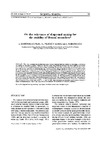Identificador persistente para citar o vincular este elemento:
https://accedacris.ulpgc.es/jspui/handle/10553/238
| Título: | On the relevance of diapycnal mixing for the stability of frontal meanders | Autores/as: | Rodríguez Santana, Ángel Pelegrí Llopart, José Luis Sangrà, Pablo Marrero Díaz, Ángeles |
Clasificación UNESCO: | 2204 Física de fluidos 251007 Oceanografía física |
Palabras clave: | Diapycnal mixing Barotropic instability Meanders Oceanic jets Atmospheric jets |
Fecha de publicación: | 2001 | Publicación seriada: | Scientia Marina | Conferencia: | Workshop and Conference on Oceanography | Resumen: | This work examines the possible importance of shear-induced diapycnal mixing in controlling the evolutionand stability of meanders in oceanic frontal jets. We first review the conditions necessary for vortex stability and investi-gate how these may be modified in the presence of diapycnal mixing. The procedure used is rather crude but provides a mea-sure of the relative importance of diapycnal mixing. It consists in constructing a simplified equation for the radial velocitythat retains the density tendency and examining under what circumstances this velocity may grow in time. Next, we use asimple two-dimensional isopycnic model to examine the intensity of diapycnal mixing in meanders. In the model the along-front velocity is in geostrophic balance and the ageostrophic contributions are an oscillating deformation field and diapyc-nal mass exchange. The horizontal deformation field increases the slope of the isopycnals in temporal scales typical of GulfStream meanders, causing a reduction of the gradient Richardson number, Ri. The diapycnal flux is calculated as the diver-gence of the density Reynolds flux, which is parameterized in terms of Ri.The results of the model show that diapycnal mix-ing increases during the frontogenetical stages, reaching density tendency values of the order of 10-4kg m-3s-1and conver-gence/divergence values of the order of 10-3s-1. It turns out that diapycnal mixing in meanders may be intense enough to control the separation and slope of the isopycnals and to condition the possibility of barotropic instability. | URI: | https://accedacris.ulpgc.es/handle/10553/238 | ISSN: | 0214-8358 | DOI: | 10.3989/scimar.2001.65s1259 | Fuente: | Scientia Marina [ISSN 0214-8358], v. 65 (Suppl. 1), p. 259-267 |
| Colección: | Artículos |
Citas SCOPUSTM
4
actualizado el 08-jun-2025
Citas de WEB OF SCIENCETM
Citations
5
actualizado el 08-jun-2025
Visitas
177
actualizado el 01-dic-2024
Descargas
163
actualizado el 01-dic-2024
Google ScholarTM
Verifica
Altmetric
Comparte
Exporta metadatos
Los elementos en ULPGC accedaCRIS están protegidos por derechos de autor con todos los derechos reservados, a menos que se indique lo contrario.
